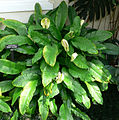Spathiphyllum
| Spathiphyllum subsp. var. | Peace lily, Spath | |||||||||||||||||||||||||||||||||||||||||||||||||||||||
|---|---|---|---|---|---|---|---|---|---|---|---|---|---|---|---|---|---|---|---|---|---|---|---|---|---|---|---|---|---|---|---|---|---|---|---|---|---|---|---|---|---|---|---|---|---|---|---|---|---|---|---|---|---|---|---|---|
| Error creating thumbnail: convert: unable to open image `/mnt/data/www/gardenology/w/images/2/2c/Spathiphyllum_floribundum1.jpg': No such file or directory @ blob.c/OpenBlob/2480.
convert: missing an image filename `/tmp/transform_1b76b74-1.jpg' @ convert.c/ConvertImageCommand/2838. |
|
| ||||||||||||||||||||||||||||||||||||||||||||||||||||||
| ||||||||||||||||||||||||||||||||||||||||||||||||||||||||
Spathiphyllum is a genus of about 40 species of monocotyledonous flowering plants in the family Araceae, native to tropical regions of the Americas and southeastern Asia. Certain species of Spathiphyllum are commonly known as Spath or Peace Lilies.
They are evergreen herbaceous perennial plants with large leaves 12-65 cm long and 3-25 cm broad. The flowers are produced in a spadix, surrounded by a 10-30 cm long, white, yellowish, or greenish spathe. The plant does not need excessive light or water to survive.
Several species are popular indoor houseplants. Spathiphyllum cleans indoor air of many environmental contaminants, including benzene, formaldehyde, and other pollutants.[1][2] It cleans best at one plant per 10 m².[3] It lives best in shade and needs little sunlight to thrive. It is watered approximately once a week. The soil is best left moist but only needs watering if the soil is dry. [4]
| Standard Cyclopedia of Horticulture |
|---|
|
Spathiphyllum (Greek word, referring to the leaf-like spathes). Araceae. Stemless or short-stemmed herbs, used as warmhouse foliage plants. Leaves large, oblong or lanceolate, acuminate or cuspidate, midrib strong: spathe lf .-like, membranaceous, oblong or lanceolate; spadix shorter than the spathe, sessile or stipitate, cylindrical, densely fld.: fls. hermaphrodite, all fertile; perianth-segms. 4, 6, or 8, connate or coherent in a truncate or lobed cup; stamens 4, 6, or 8; ovary oblong, 3-4-celled: berry globose or oblong-conical, 3-celled, cells 1-2-seeded.—About 27 species, mostly from Trop. Amer., one or two Malayan. Monographed by Engler and Krause in Engler's Pflanzenreich, hft. 37 (IV. 23B), 1908. Gardeners recommend as soil for their cult. a mixture of leaf-mold, peat, and fibrous loam, together with some sand and charcoal. S. Ghiesbreghtii, Hort., is offered in the trade, but is unknown botanically.—S. pictum, Hort. Lind. – Rhodospatha picta. CH
|
Cultivation
- Do you have cultivation info on this plant? Edit this section!
Propagation
- Do you have propagation info on this plant? Edit this section!
Pests and diseases
- Do you have pest and disease info on this plant? Edit this section!
Species
- Selected specieswp
Hybrids:
Gallery
- Error creating thumbnail: convert: unable to open image `/mnt/data/www/gardenology/w/images/2/2c/Spathiphyllum_floribundum1.jpg': No such file or directory @ blob.c/OpenBlob/2480.
convert: missing an image filename `/tmp/transform_39905f6-1.jpg' @ convert.c/ConvertImageCommand/2838.
Spathiphyllum floribundum
- Peace lily.jpg
Close up view of Peace Lily
References
- Standard Cyclopedia of Horticulture, by L. H. Bailey, MacMillan Co., 1963
External links
- w:Spathiphyllum. Some of the material on this page may be from Wikipedia, under the Creative Commons license.
- Spathiphyllum QR Code (Size 50, 100, 200, 500)
Cite error:
<ref> tags exist, but no <references/> tag was found



